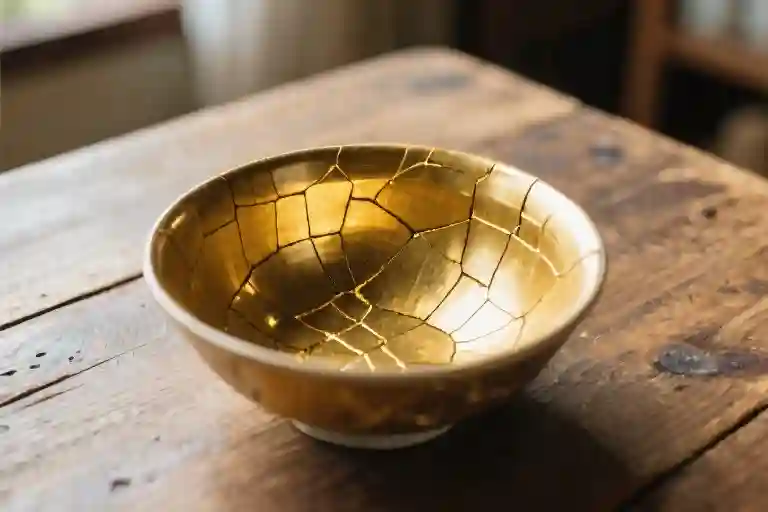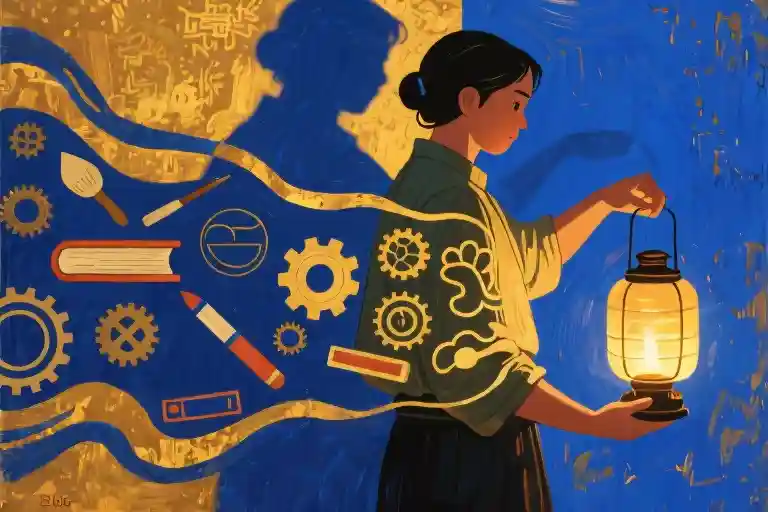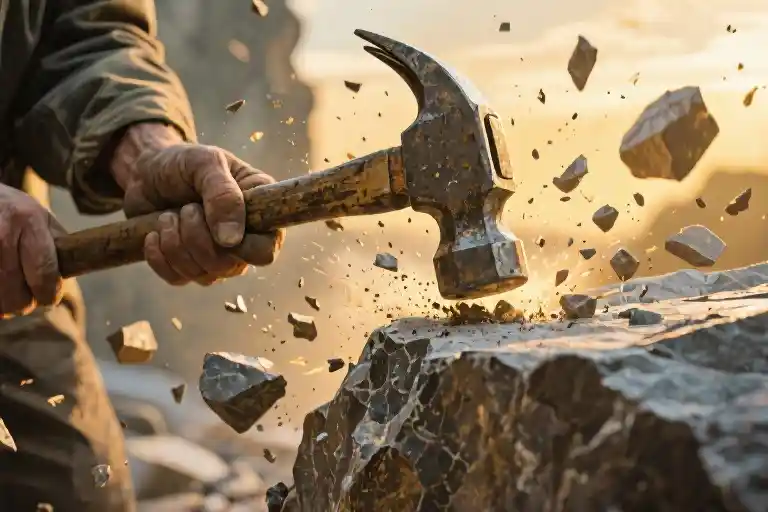There’s a peculiar kind of liberation that comes with understanding your existence as temporary—not as a flaw to be corrected, but as a canvas where every emotion, from the most radiant joy to the most shattering grief, gets to leave its mark. This realization carries both the sweetness of freedom and the bitterness of impermanence, like biting into dark chocolate that’s 85% cacao.
We spend so much energy running from what we perceive as wrong turns—the failed relationships, career missteps, or moments when we betrayed our own values. But what if these weren’t deviations from some imaginary perfect path? What if that night you spent crying over someone who left was actually teaching you how to love yourself? Or that job rejection forced you to develop skills you’d never have pursued otherwise?
The Japanese art of kintsugi offers a useful metaphor here. When a ceramic piece breaks, artisans repair it with gold lacquer, not to hide the cracks but to highlight them as part of the object’s history. Your emotional fractures work the same way—they’re not evidence of damage but proof of your capacity to hold more light than before. Those sleepless nights when your mind raced through every possible catastrophe? They were forging neural pathways for resilience you’ll draw on later.
Consider how muscles grow. Strength training creates microscopic tears in muscle fibers, and it’s during the repair process that the tissue becomes stronger. Emotional and psychological growth follows the same paradoxical principle—we expand through controlled breakdowns. The anxiety attack that left you breathless last year? It was recalibrating your sensitivity thresholds. The friendship that ended painfully? It was making space for relationships with better boundaries.
Yet this perspective often feels impossible when we’re in the thick of suffering. In those moments, the idea that pain has purpose can sound like spiritual bypassing. That’s okay. You don’t have to believe it while you’re hurting. The understanding tends to arrive later, in unexpected flashes—maybe when you’re washing dishes and suddenly recognize how a past failure prepared you for a current challenge.
Here’s what neuroscience tells us: Every significant emotional experience rewires your brain. The neural pathways formed during heartbreak or failure become alternate routes your mind can use when facing future obstacles. That’s why people often describe trauma survivors as having ‘depth’—their nervous systems have literally mapped more emotional territory.
So the next time you’re tempted to judge your past choices, try this reframe: Your so-called mistakes were experiments in living. Some yielded expected results, others surprised you, but all contributed data points to your ongoing research project called ‘How to Be Human.’ The variables keep changing, the hypotheses evolve, and that’s exactly how it’s meant to work.
The Hidden Curriculum of Suffering
We spend our twenties collecting bruises like merit badges – the career misstep that stung for months, the relationship that unraveled in slow motion, the opportunities we were certain we’d ruined forever. Only later do we notice how these so-called failures carved channels for wisdom to flow through. That job you lost? It made space for work that actually fits your soul. That heartbreak? It taught you boundaries you’ll carry into every future love.
Neuroscience confirms what poets always knew: emotional pain physically rewires us. When we experience profound loss, our anterior cingulate cortex – the neural switchboard for empathy – actually thickens. The same grief that hollows you out eventually becomes the vessel that lets you drink deeper from human connection. Those nights you spent dissecting every ‘what if’ weren’t wasted time; you were unconsciously mapping emotional terrain you’ll later navigate for others.
Consider the detours you once cursed. The college major you abandoned led you to mentors who shaped your worldview. The cross-country move that felt isolating became the crucible where you discovered self-reliance. Even poor decisions contain hidden curricula – the impulsive purchase that taught financial literacy through scarcity, the toxic friendship that sharpened your discernment like a whetstone.
This isn’t spiritual bypassing. The ache was real. The shame you swallowed when you disappointed others, the mornings your chest felt like shattered pottery – none of that gets erased. But meaning emerges when we stop asking ‘Why did this happen to me?’ and start wondering ‘What is this preparing me for?’ Every pivot point contains this paradox: the very experiences that make us feel most lost often become the coordinates that help others find their way.
Adulthood waits patiently to unpack harder truths. Just beyond this realization – that our wounds become wisdom – lies the unsettling awareness of life’s inherent unevenness. The same heart that learns compassion through suffering must later confront why suffering gets distributed so unjustly…
The Gravity of Reality
We enter adulthood clutching childhood’s fairy tales – that goodness always prevails, that hard work guarantees reward, that the world operates on some fundamental fairness. Then life happens. The promotion goes to the boss’s nephew. The kindest person you know gets the cruelest diagnosis. You watch entire communities work twice as hard for half as much, and something inside you fractures.
This awakening comes in layers. First, you notice how casually cruelty wears everyday disguises – the ‘harmless’ gossip that destroys reputations, the bureaucratic indifference that denies healthcare, the thousand subtle ways people prioritize convenience over compassion. Then you see the systems: how zip codes determine life expectancy more than genetics, how wealth whispers while poverty screams to be heard. The hardest lesson isn’t that bad things happen – it’s realizing how deliberately some suffering gets engineered.
I remember sitting in a hospital waiting room years ago, watching a woman plead with the billing department. Her son needed medication she couldn’t afford, not after choosing between rent and treatments. The clerk’s face stayed professionally blank while explaining payment plans. Nearby, a man in designer scrubs complained loudly about his golf game being rained out. The contrast felt violent.
These moments accumulate until you understand: survival isn’t passive. Getting up each morning in a world that profits from your exhaustion is rebellion. Loving despite reasons not to is alchemy. The journalist Martha Gellhorn put it perfectly when she said, ‘Nothing is better for self-esteem than survival.’
Yet here’s what they don’t tell you about this heavy awareness – it’s the birthplace of real strength. That woman in the hospital? She organized a community medication fund. The clerk who seemed indifferent? Later, I saw her slip the woman an envelope of samples from her own purse. Light persists in cracks we can’t even see.
This chapter of life – the one where illusions shatter – feels like carrying broken glass in your bare hands. But those cuts teach you to handle fragility, yours and others’. They show you where to apply pressure when systems bleed people dry. Most importantly, they help you recognize fellow survivors by the particular way they move through the world – not unscathed, but undefeated.
The Alchemy of Brokenness
We spend our early years building invisible armor – layer after layer of shoulds and supposed-tos, polished expectations and carefully constructed personas. Then life happens. A betrayal fractures your trust. A failure cracks your confidence. A loss shatters your heart into jagged pieces that don’t seem to fit together anymore. This is where the real magic begins.
There’s an uncomfortable truth about emotional healing: you can’t bypass the breaking to reach the becoming. The Japanese art of kintsugi offers a perfect metaphor – broken pottery repaired with gold lacquer becomes more valuable than the original piece. Your fractures aren’t flaws to hide; they’re sacred seams where new wisdom gets woven into your being.
Consider Malcolm X’s transformation during his prison years. The same isolation that could have destroyed him became the crucible for his awakening. In the stillness of his cell, the man who entered as Detroit Red emerged as a visionary leader. His darkest days contained the seeds of his greatest purpose – not despite the brokenness, but because of it. This is the paradox of post-traumatic growth: what shatters us often shows us who we’re meant to become.
Three counterintuitive truths emerge from this alchemical process:
- To heal, you must first stop pretending you’re not wounded. That nagging pain you keep numbing? It’s actually your compass. Those middle-of-the-night anxieties aren’t malfunctions – they’re messengers pointing toward unfinished emotional business. Healing begins when you turn toward what hurts with curiosity rather than resistance.
- Love grows deepest roots in broken soil. Ever noticed how the most compassionate people you know have usually weathered significant pain? There’s a neurological reason – trauma actually rewires the brain to enhance emotional attunement. The cracks in your heart become conduits for others’ pain, making you someone who doesn’t just offer sympathy but truly understands.
- Clarity comes through cloudiness. Like a shaken snow globe, our most chaotic moments eventually settle into surprising patterns. That career setback that felt like the end? It created space for work that actually fulfills you. That relationship that fell apart? It taught you boundaries you’ll carry forward. The mess isn’t the mistake – it’s the necessary middle stage of metamorphosis.
Modern psychology confirms what ancient wisdom traditions always knew: we integrate light and shadow not through avoidance, but through courageous confrontation. Dr. Judith Herman’s research on trauma recovery reveals that healing occurs in three phases – safety, remembrance/mourning, and reconnection. Notice the essential middle step? You have to pass through the valley of honest grieving to reach renewed wholeness.
Right now, someone reading this is sitting with their particular brokenness – maybe a failed business, a diagnosis, or the aftershocks of loss. Here’s what I wish someone had told me during my own fractures: the weight you’re carrying isn’t proof you’re failing; it’s evidence you’re doing the brave work of transformation. Those sleepless nights when you’re replaying every ‘if only’? They’re not wasted time. They’re the quiet hours where your psyche rearranges the pieces into new configurations.
Now, let’s forge this wisdom into tools. When the next wave of pain comes (because more will come – that’s the deal with being alive), try this: instead of asking ‘Why is this happening to me?’, experiment with ‘What is this trying to show me?’ The question won’t erase the hurt, but it might help you spot the first glints of gold in your cracks.
Your broken places aren’t the end of your story. They’re the plot twists that make it worth telling.
Mapping Your Healing
Healing begins when we stop fighting our scars and start listening to them. Those cracks you’ve been trying to hide? They’re not evidence of damage—they’re the sacred geography of your becoming. Here’s how to transform your pain into practical wisdom.
The 3-Minute Forgiveness Practice
Set your phone timer (because grace needs boundaries too). Close your eyes and breathe in through your nose for four counts—imagine drawing in compassion like mountain air. Hold for two beats—let it circulate through every cell that’s ever felt unworthy. Exhale slowly through pursed lips—releasing that old shame like autumn leaves. Repeat three times while whispering: “This pain taught me __, and for that I thank it.”
Neuroscience shows this simple ritual can rewire the amygdala’s fear response within 21 days. The key isn’t to erase the memory, but to change your body’s reaction to it.
The Gift-Wrapping Journal Method
Grab any notebook and divide two pages like this:
Left Page (The Wound)
- Describe one painful experience in vivid detail (the betrayal, the failure, the loss)
- Note where you still feel tension when remembering it
Right Page (The Gift)
- List three unexpected strengths this forged in you (e.g., “Being fired taught me to trust my creative instincts”)
- Write one sentence as if advising a friend with this wound
This isn’t toxic positivity—it’s alchemy. By week three, most people discover their “worst” experiences birthed their most valuable tools.
Cracks Become Bridges
That relationship that left you shattered? It’s now your compass for healthy boundaries. The career setback that felt like death? It was fertilizer for unexpected growth. Start small: today, thank one old scar for its hidden service. Whisper to that younger version of you: “We couldn’t see it then, but this was preparing us for __.”
Light always enters through broken places—not despite them, but because of them. Your healing isn’t about fixing what was damaged; it’s about finally seeing the gold in the cracks.
The Light That Finds You
There’s a quiet poetry in how the same hands that once clenched in pain eventually learn to uncurl—palms open, ready to receive whatever comes next. That bittersweet freedom we began with? It wasn’t just an abstract idea. You’ve lived it through every chapter of this journey: the redirections disguised as failures, the heartbreaks that carved space for deeper love, the unbearable weight that turned out to be the price of wings.
Rumi wrote, ‘The wound is the place where the light enters you.’ Centuries later, we still find truth in those words because human suffering has an uncanny way of becoming human radiance. Your cracks—the ones you once resented for making you feel broken—are precisely what allow your particular light to spill into the world. Not despite your scars, but through them.
Perhaps this is what survival really means: not white-knuckling your way through life, but developing the courage to stay porous. To let the world leave its marks on you, then alchemize those marks into meaning. The sleepless nights, the grief you thought would drown you, the moments when adulthood’s harsh truths left you breathless—they were never obstacles to your becoming. They were the curriculum.
So here we are, back where we started yet somehow further along. That question hanging in the air—Which lesson will you thank your pain for today?—isn’t rhetorical. It’s an invitation to trace the contours of your own resilience. Maybe it’s the job loss that taught you adaptability. The betrayal that revealed your boundaries. The depression that deepened your compassion. There are no small answers here.
This isn’t about romanticizing suffering. Some wounds leave permanent shadows. But even in those shadows, light has a way of arriving—not as a blinding epiphany, but as a gradual dawning. The kind you notice one ordinary morning when you catch yourself humming again, or laughing without rehearsing it first, or recognizing that the same heart once shattered is now beating stronger for having known both breaking and mending.
Let’s leave the door open here, the way light prefers it. No tidy conclusions, because your story isn’t finished. Just this quiet knowing: the same light that found Rumi in his wounds, that illuminated Mandela’s prison cell, that guided Malala back to her voice—it’s been seeking you all along. Not to erase your struggles, but to reveal their hidden contours. Not to promise a painless life, but to remind you that even in the unraveling, you’re being woven into something vast and beautiful.
Your next chapter won’t look like anyone else’s. That’s the point. But when the weight feels familiar, remember—you’ve carried this before. And the light? It remembers how to find you.





